Assessing the Impact of Groundwater Extraction and Climate Change on a Protected Playa-Lake System in the Southern Iberian Peninsula: La Ratosa Natural Reserve
Abstract
1. Introduction
1.1. Geological Setting of La Ratosa Playa-Lake System
1.2. Climatic Setting
1.3. Hydrological and Hydrogeological Setting
2. Materials and Methods
2.1. Water Level Monitoring
2.2. Water Level Modelling
2.3. Climate Change Scenarios
2.4. Structural Data
3. Results
3.1. Geological Results
3.2. Water Level Variations, Modelling and Validation
3.3. Climate Change Scenarios
3.4. Hydrogeological Evolution of La-Camorra Aquifer
4. Discussion
4.1. Origin and Hydrogeological Evolution of La Ratosa System
4.2. Comparison with Great Hungarian Plain Playa-Lakes
5. Conclusions
Author Contributions
Funding
Data Availability Statement
Conflicts of Interest
References
- Meza-Rodríguez, D.; Anda, J.; Shear, H. Lake Atotonilco: A first approach to determining the minimum lake level necessary to sustain its biodiversity. Ann. Am. Assoc. Geogr. 2023, 113, 2318–2332. [Google Scholar] [CrossRef]
- Gil-Márquez, J.M.; Andreo, B.; Mudarra, M. Comparative analysis of runoff and evaporation assessment methods to evaluate wetland–groundwater interaction in Mediterranean evaporitic-karst aquatic ecosystem. Water 2021, 13, 1482. [Google Scholar] [CrossRef]
- Yang, Z.; Hu, L.H.; Zhang, W. Hydrochemical Characteristics of Groundwater and Their Significance in Arid Inland Hydrology. Water 2023, 15, 1641. [Google Scholar] [CrossRef]
- Fessahaye, A.K.; Xie, Y.; Hu, Y.; Dai, G.; Zheng, H.; Teng, W. Groundwater Over-Extraction: Comprehensive Review of Socio-economic Impacts and Pathways to Sustainable Management. Eur. J. Theor. Appl. Sci. 2025, 3, 190–211. [Google Scholar] [CrossRef]
- Rodríguez-Rodríguez, M.; Martos-Rosillo, S.; Pedrera, A.; Benavente-Herrera, J. Ratosa playa lake in southern Spain. Karst pan or compound sink? Environ. Monit. Assess. 2015, 187, 175. [Google Scholar] [CrossRef]
- Azañón Hernández, J.M.; Pérez-Peña, J.V.; Giaconia, F.; Booth-Rea, G.; Martínez Martínez, J.M.; Rodríguez-Peces, M.J. Active tectonics in the central and eastern Betic Cordillera through morphotectonic analysis: The case of Sierra Nevada and Sierra Alhamilla. J. Iber. Geol. 2012, 38, 225–238. [Google Scholar]
- Marín-Lechado, C.; Pedrera Parias, A.; Ruiz Constán, A.; Peláez Montilla, J.A.; González Ramón, A. Deformation pattern of the Eastern Guadalquivir foreland basin (Southern Spain). Tectonics 2018, 36, 1072–1089. [Google Scholar] [CrossRef]
- González-Castillo, L.; Galindo-Zaldívar, J.; Pedrera, A.; Martínez-Moreno, F.J.; Ruano, P. Shallow frontal deformation related to active continental subduction: Structure and recent stresses in the westernmost Betic Cordillera. Terra Nova 2015, 27, 114–121. [Google Scholar] [CrossRef]
- Ruiz-Constán, A.; Pedrera, A.; Galindo-Zaldívar, J.; Pous, J.; Arzate, J.; Roldán-García, F.J.; Anahnah, F. Constraints on the frontal crustal structure of a continental collision from an integrated geophysical research: The central-western Betic Cordillera (SW Spain). Geochem. Geophys. Geosystems 2012, 13, 1–19. [Google Scholar] [CrossRef]
- Garcia–Castellanos, D.; Fernandez, M.; Torné, M. Modeling the evolution of the Guadalquivir foreland basin (southern Spain). Tectonics 2002, 21, 91917. [Google Scholar] [CrossRef]
- Ruano, P.; Galindo-Zaldívar, J.; Jabaloy, A. Recent tectonic structures in a transect of the Central Betic Cordillera. Pure Appl. Geophys. 2004, 161, 541–563. [Google Scholar] [CrossRef]
- Jiménez-Bonilla, A.; Martegani, L.; Rodríguez-Rodríguez, M.; Gázquez, F.; Díaz-Azpíroz, M.; Martos, S.; Expósito, I. The role of neotectonics and climate variability in the Pleistocene-to-Holocene hydrological evolution of the Fuente de Piedra playa lake (southern Iberian Peninsula). Hydrol. Earth Syst. Sci. 2024, 28, 5311–5329. [Google Scholar] [CrossRef]
- Essenwanger, O.M. General Climatology 1C: Classification of Climates; Elsevier: Amsterdam, The Netherlands, 2001. [Google Scholar]
- Halmos, L.; Delgado Rodríguez, J.M.; Rodríguez Rodríguez, M.; Jiménez Bonilla, A.; Díaz Azpiroz, M. Physicochemical characteristics of playa-lake sediments located in the western External Betics. Geogaceta 2022, 72, 39–42. [Google Scholar] [CrossRef]
- Pedrera, A.; Martos-Rosillo, S.; Galindo-Zaldívar, J.; Rodríguez-Rodríguez, M.; Benavente, J.; Martín-Rodríguez, J.F.; Zúñiga-López, M.I. Unravelling aquifer-wetland interaction using CSAMT and gravity methods: The Mollina-Camorra aquifer and the Fuente de Piedra playa-lake, southern Spain. J. Appl. Geophys. 2016, 129, 17–27. [Google Scholar] [CrossRef]
- Hargreaves, G.H.; Samani, Z.A. Reference crop evapotranspiration from temperature. Appl. Eng. Agric. 1985, 1, 96–99. [Google Scholar] [CrossRef]
- Montes-Vega, M.J.; Guardiola-Albert, C.; Rodríguez-Rodríguez, M. Calculation of the SPI, SPEI, and GRDI Indices for Historical Climatic Data from Doñana National Park: Forecasting climatic series (2030–2059) using two climatic scenarios RCP 4.5 and RCP 8.5 by IPCC. Water 2023, 15, 2369. [Google Scholar] [CrossRef]
- Daniel, D.W.; Smith, L.M.; McMurry, S.T.; LaGrange, T.; Stutheit, R.; Tangen, B.A.; Dahl, C.F. Greenhouse Gas Fluxes and Carbon Storage Dynamics in Playa Wetlands: Restoration Potential to Mitigate Climate Change. In Conservation Effects Assessment Project (CEAP)—Wetlands, Science Note; United States Department of Agriculture (USDA); Natural Resources Conservation Service (NRCS): Washington, DC, USA, 2016; p. 7. [Google Scholar]
- Kohfahl, C.; Rodriguez, M.; Fenk, C.; Menz, C.; Benavente, J.; Hubberten, H.; Pekdeger, A. Characterising flow regime and interrelation between surface-water and ground-water in the Fuente de Piedra salt lake basin by means of stable isotopes, hydrogeochemical and hydraulic data. J. Hydrol. 2008, 351, 170–187. [Google Scholar] [CrossRef]
- Sociedad Geologica de España. Geología de España; Vera, J.A., Ed.; SGE-IGME: Madrid, Spain, 2004. [Google Scholar]
- Suppe, J.; Sàbat, F.; Munoz, J.A.; Poblet, J.; Roca, E.; Vergés, J. Bed-by-bed fold growth by kink-band migration: Sant Llorenç de Morunys, eastern Pyrenees. J. Struct. Geol. 1997, 19, 443–461. [Google Scholar] [CrossRef]
- Gurdak, J.J.; Roe, C.D. Recharge Rates and Chemistry Beneath Playas of the High Plains Aquifer—A Literature Review and Synthesis; Prepared in Cooperation with Playa Lakes Joint Venture; U.S. Geological Survey Circular 1333: Denver, CO, USA, 2009; p. 39.
- Labbe, J.; Celle, H.; Devidal, J.; Albaric, J.; Mailhot, G. Combined Impacts of Climate Change and Water Withdrawals on the Water Balance at the Watershed Scale—The Case of the Allier Alluvial Hydrosystem (France). Sustainability 2023, 15, 3275. [Google Scholar] [CrossRef]
- Zhang, H.; Tang, Z.; Bishop, A.; Drahota, J.; LaGrange, T.; Varner, D. Conservation significantly improves wetland conditions: Evaluation of playa wetlands in different conservation status. Wetl. Ecol. Manag. 2020, 28, 85–102. [Google Scholar] [CrossRef]
- Busa-Fekete, B.; Hegyi, R.; Szanyi, J. The hydrogeological aspects of Lake Fehér, Kardoskút, Southern Hungary. Acta Mineral. Petrogr. 2003, 44, 35–41. [Google Scholar]
- Sümegi, P.; Lócskai, T.; Hupuczi, J. Late Quaternary palaeoenvironment and palaeoclimate of the Lake Fehér (Fehér-tó) sequence at Kardoskút (South Hungary), based on preliminary mollusc records. Open Geosci. 2011, 3, 43–52. [Google Scholar] [CrossRef]
- Rakonczai, J.; Bódis, K. A Környezeti Változások Következményei az Alföld Felszín Alatti Vízkészleteiben. Jakucs, L., Ed.. Ph.D. Thesis, University of Szeged, Szeged, Hungary, 2002; pp. 227–238. [Google Scholar]
- Rakonczai, J. A Klímaváltozás Következményei a Dél-Alföldi Tájon (A Természeti Földrajz Változó Szerepe és Lehetőségei)—The consequences of climate change in the Southern Great Plain (The changing role and possibilities of physical geography). Ph.D. Thesis, Hungarian Academy of Sciences, Szeged, Hungary, 2013; p. 167. [Google Scholar]
- Biró, M.; Révész, A.; Molnár, Z.; Horváth, F. Regional habitat pattern of the Danube–Tisza Interfluve in Hungary, I: The landscape structure and habitat pattern; the fen and alkali vegetation. Acta Bot. Hung. 2007, 49, 267–303. [Google Scholar] [CrossRef]
- Tóth, T. Dynamics of Salt Accumulation in the Danube Valley. International Salinity Forum; Oral Presentation Abstracts; Riverside: Rolling Meadows, IL, USA, 2005; pp. 449–452. [Google Scholar]
- Halmos, L.; Bozsó, G.; Pál-Molnár, E. Alkaline lake system in Danube and Tisza interfluve (Szeged, HU)—Climate change and landscape degradation. Visegr. J. Bioeconomy Sustain. Dev. 2014, 3, 77–81. [Google Scholar] [CrossRef]
- Poff, N.L.; Zimmerman, J.K. Ecological responses to altered flow regimes: A literature review to inform the science and management of environmental flows. Freshw. Biol. 2010, 55, 194–205. [Google Scholar] [CrossRef]
- Hiraga, Y.; Kazama, S.; Ekkawatpanit, C.; Touge, Y. Impact of reclamation on the environment of the lower Mekong river basin. J. Hydrol. Reg. Stud. 2018, 18, 143–155. [Google Scholar] [CrossRef]
- Zhang, B.; Niu, Z.; Zhang, D.; Huo, X. Dynamic changes and driving forces of alpine wetlands on the Qinghai–Tibetan Plateau based on long-term time series satellite data: A case study in the Gansu Maqu wetlands. Remote Sens. 2022, 14, 4147. [Google Scholar] [CrossRef]
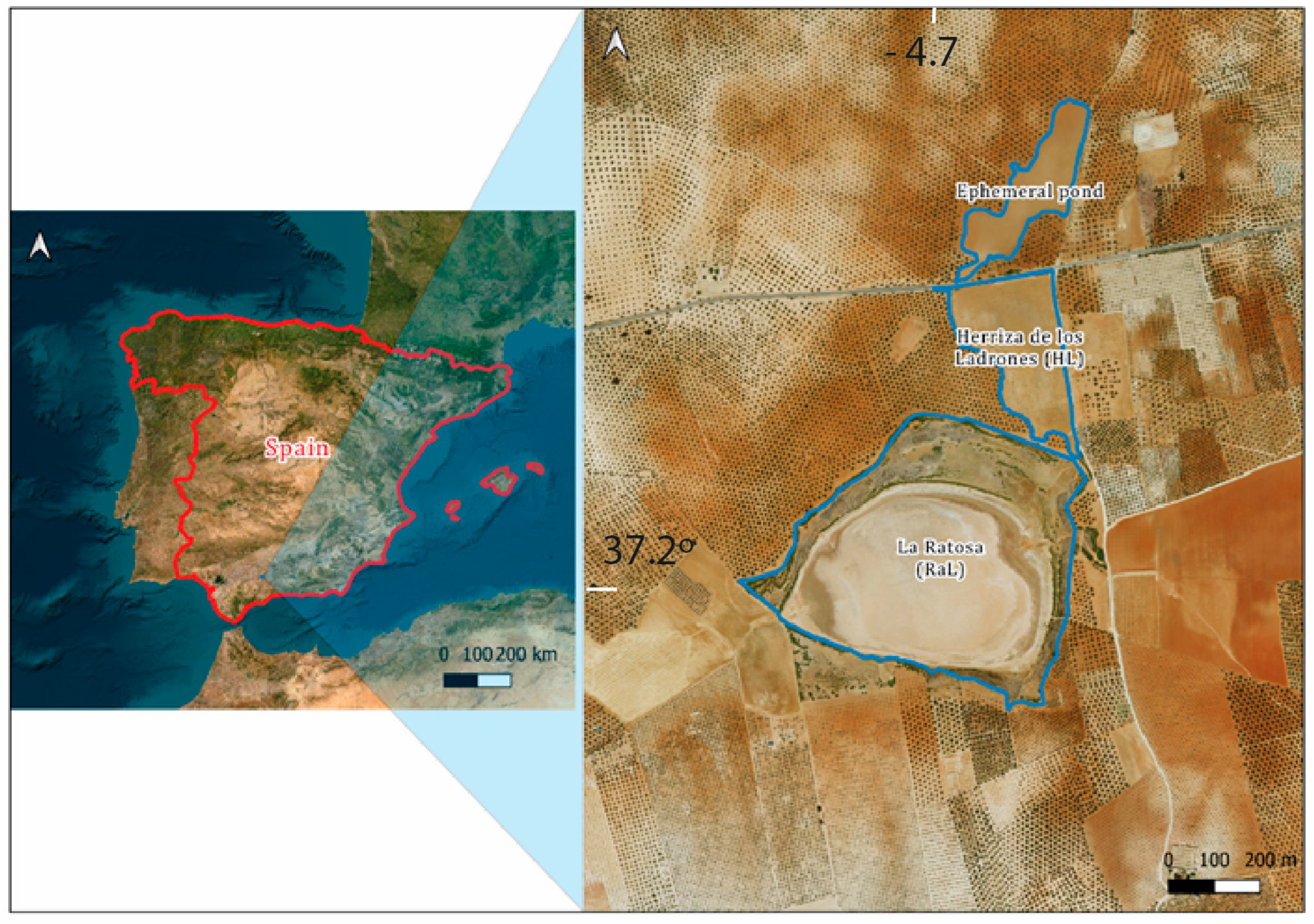
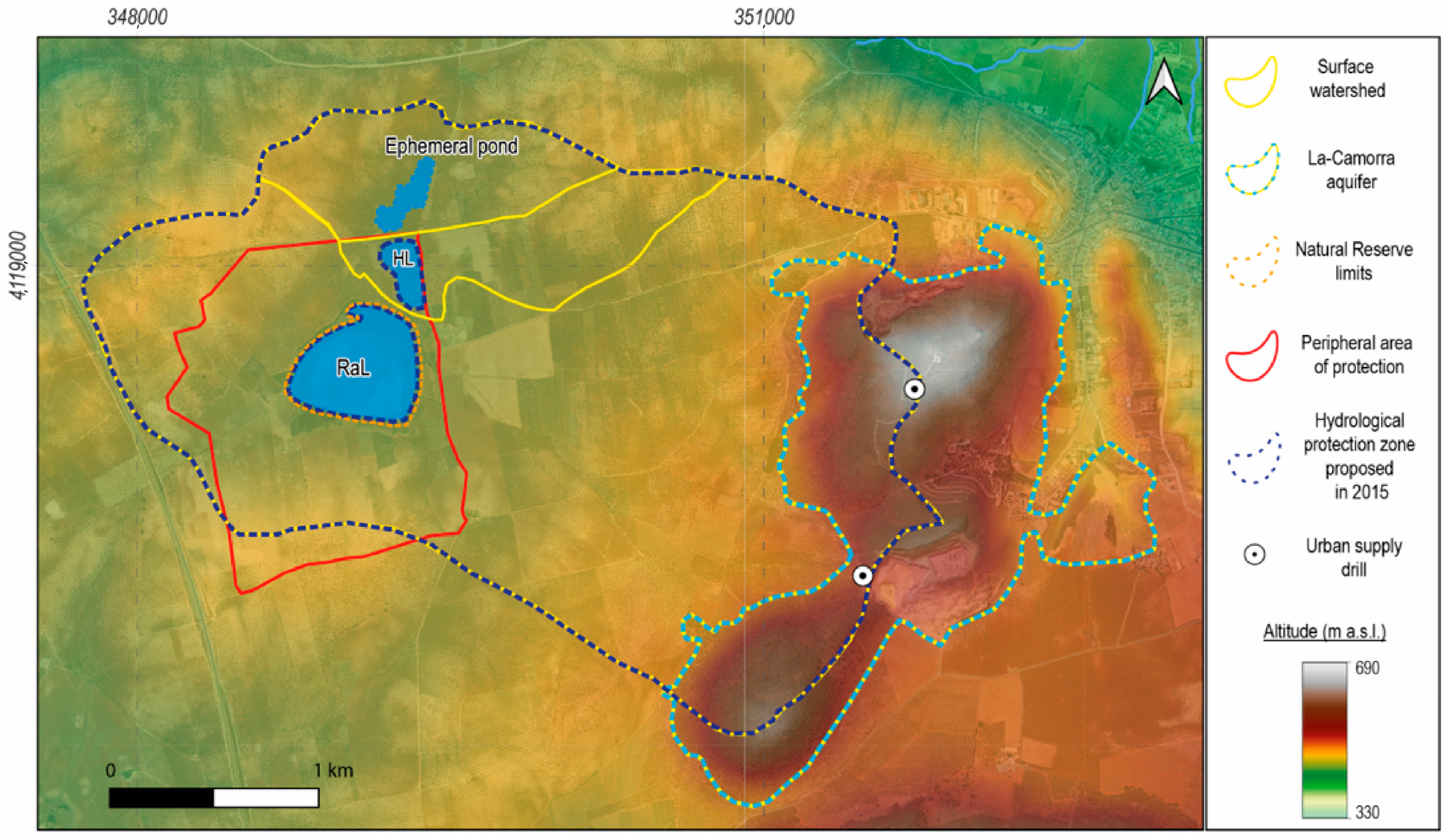
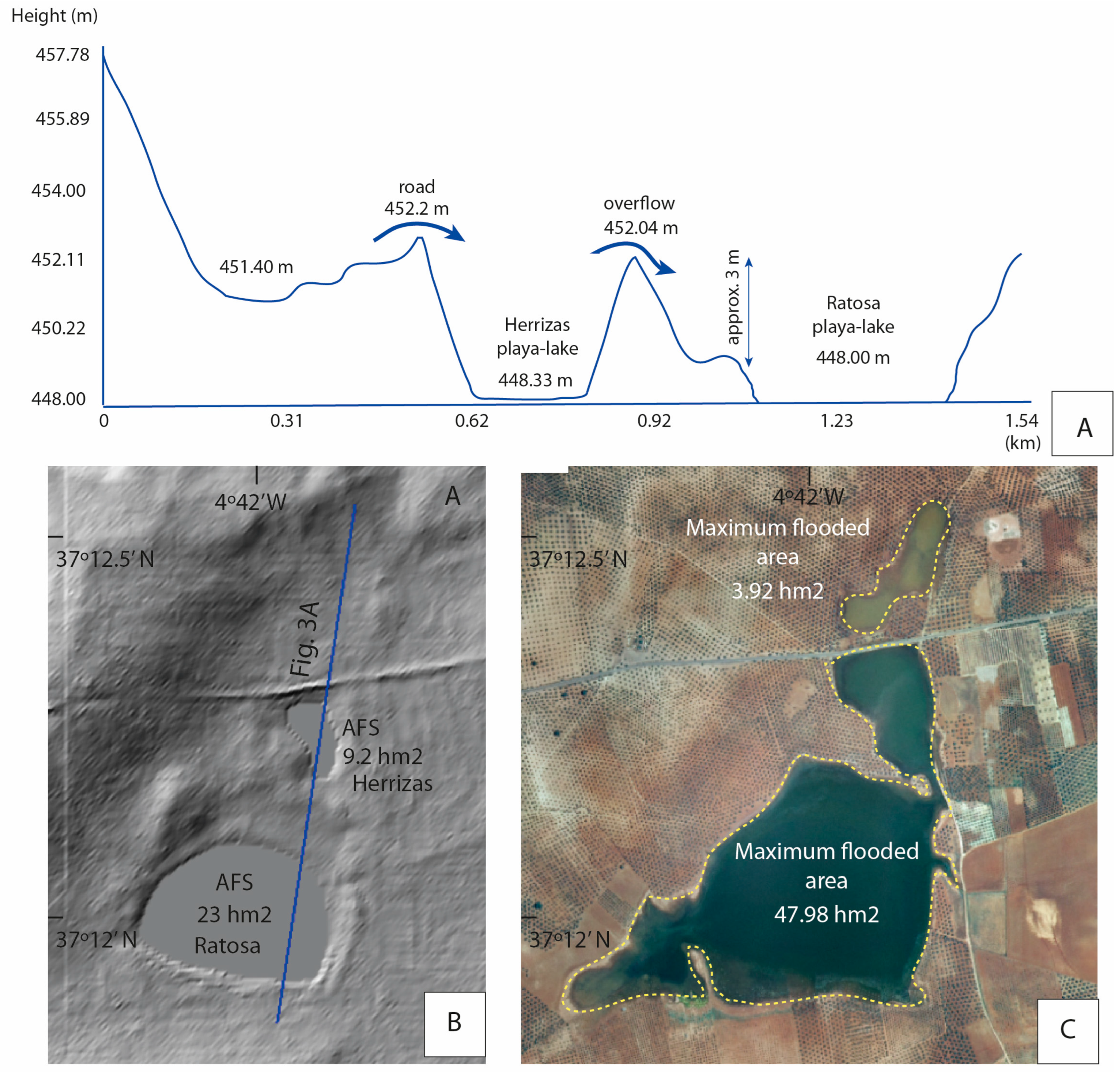
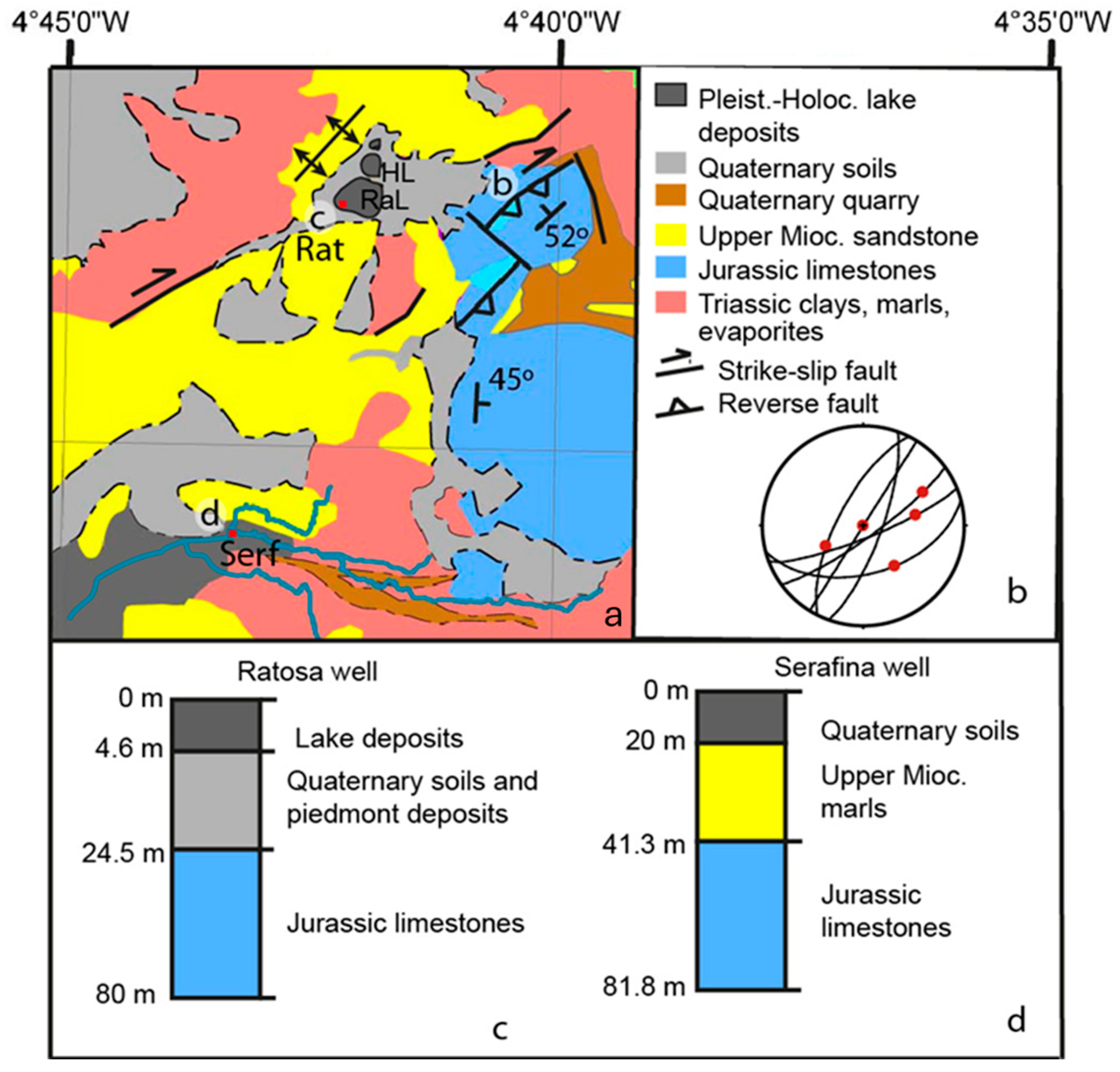
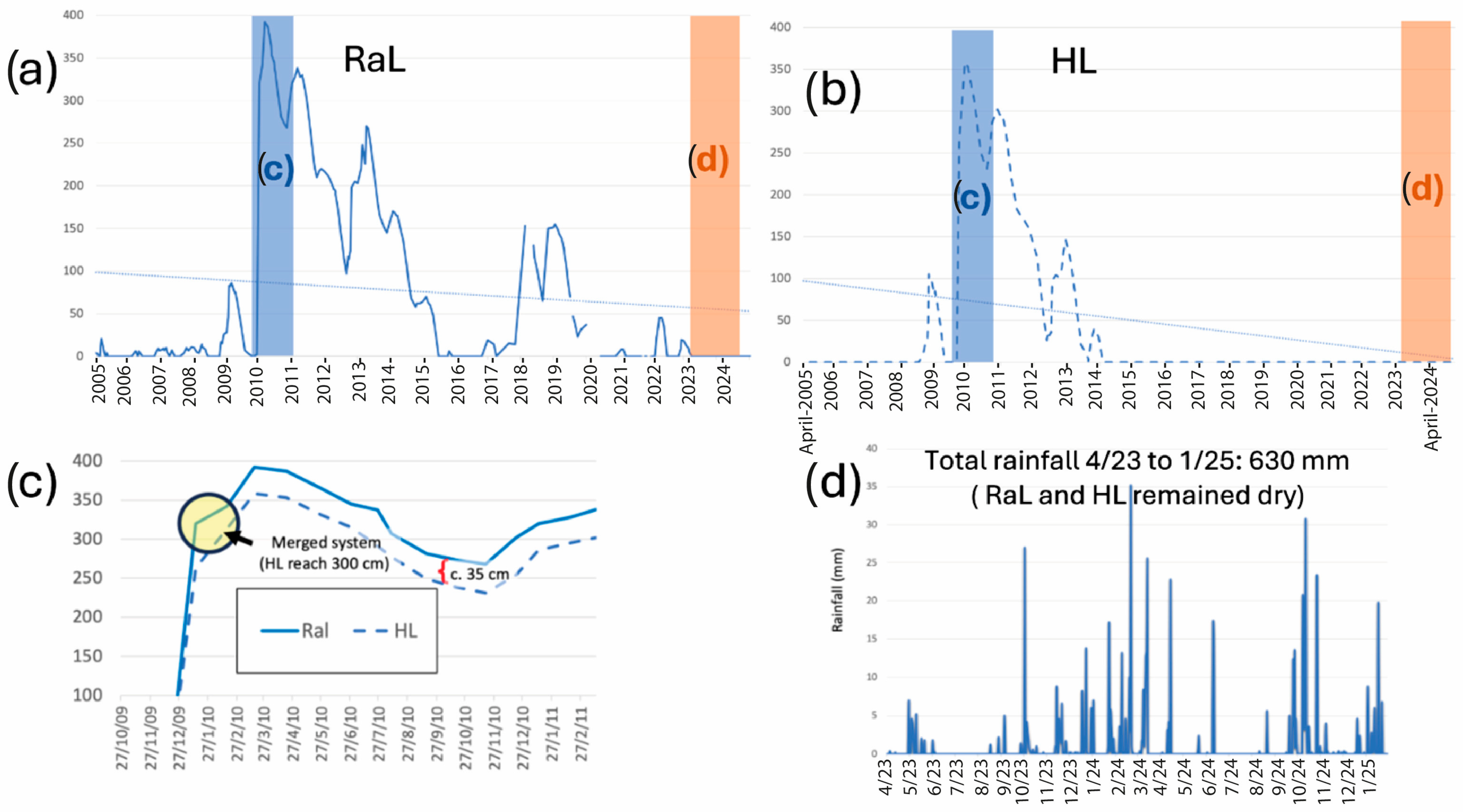
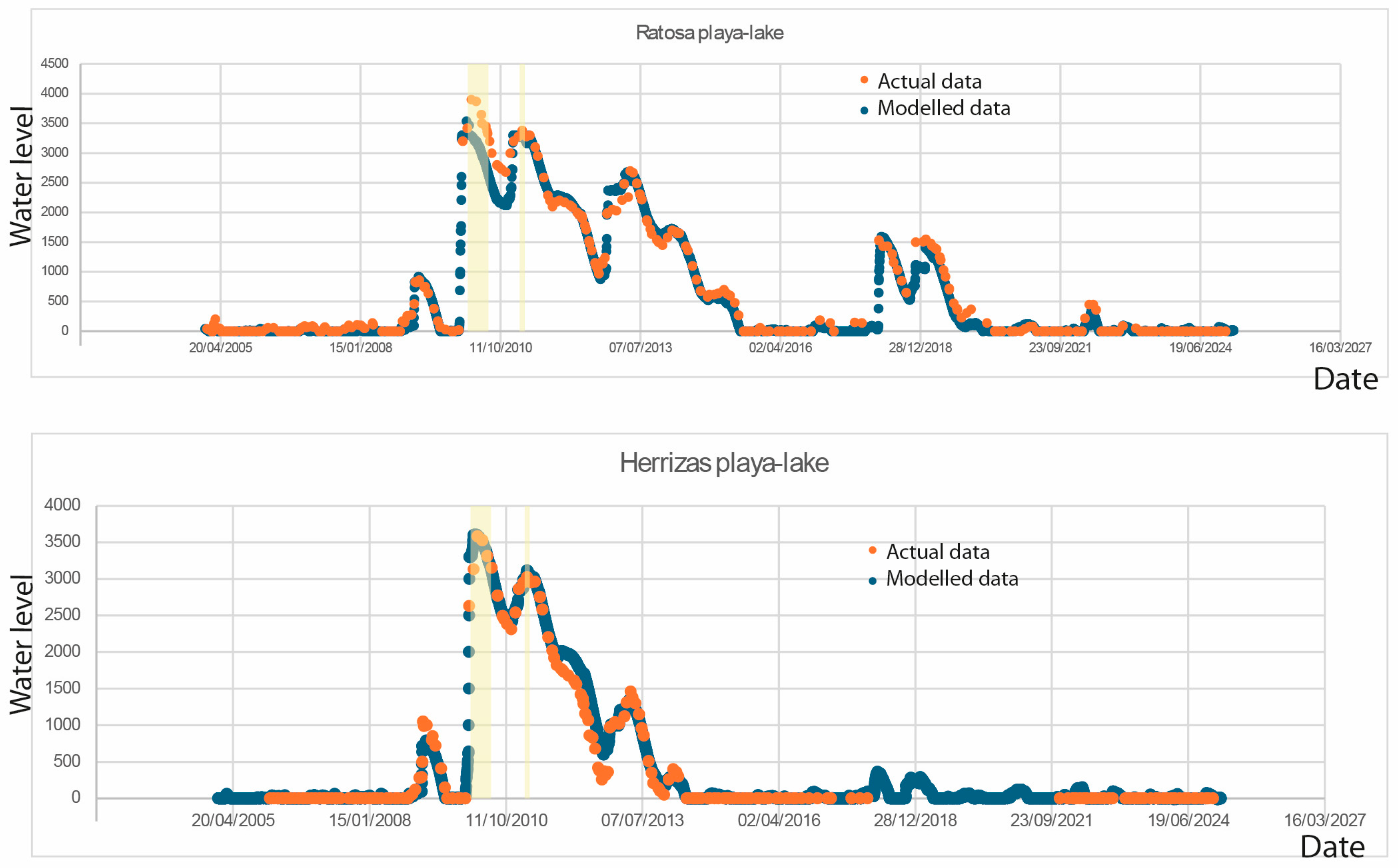
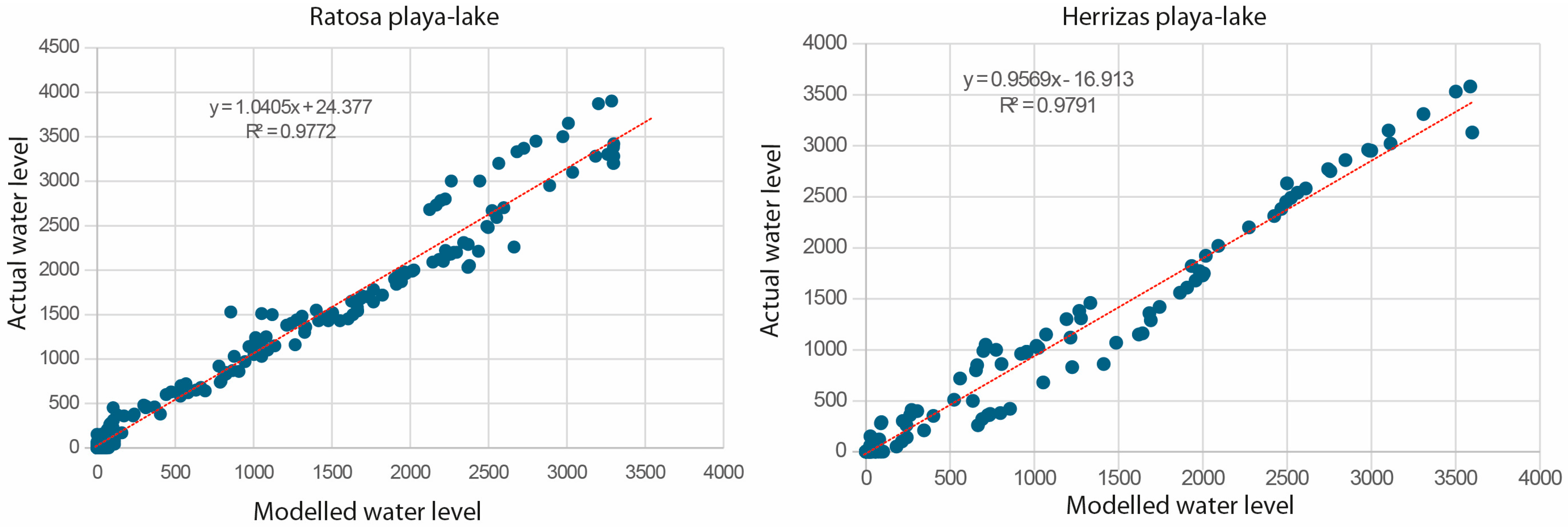

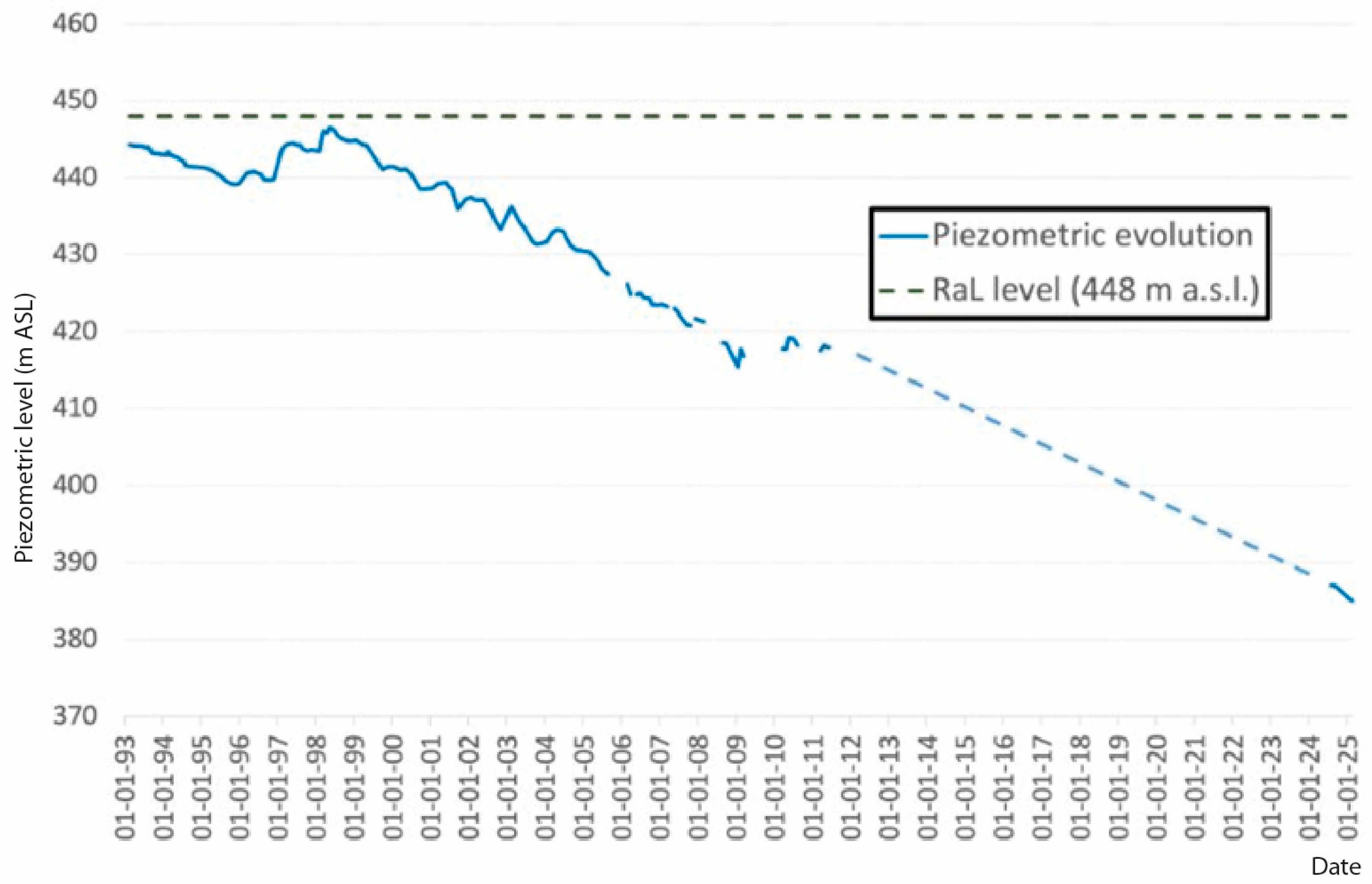
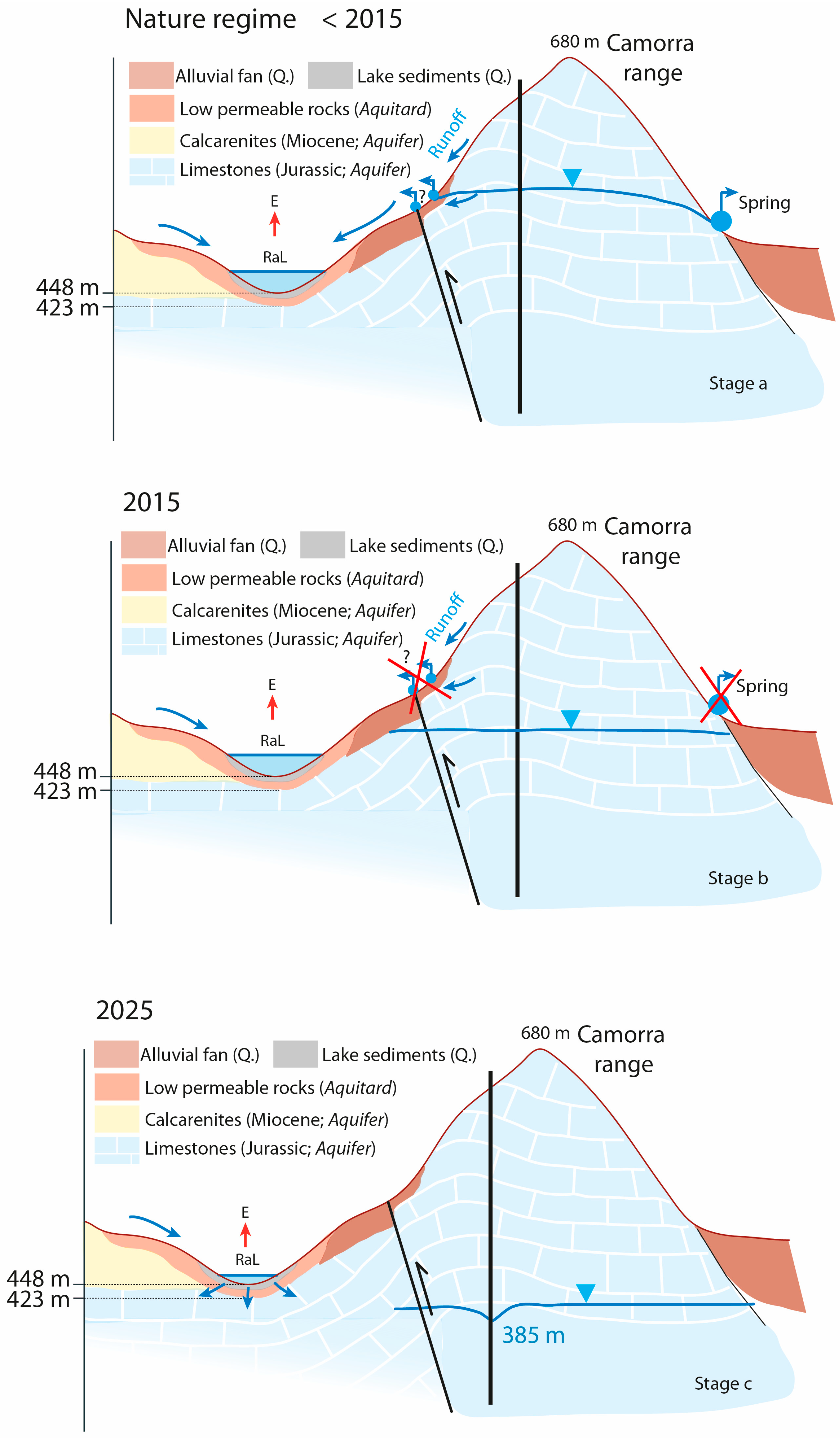



| Watershed (hm2) | Flooded Area (hm2) | Relationship (W/Flooded Área) | ||
|---|---|---|---|---|
| RaL | 557 | 23 | 24 | average year |
| HL | 150 | 9.2 | 16 | average year |
| Ratosa system | 797 | 52 | 15 | wet year (water level > 3 m) |
Disclaimer/Publisher’s Note: The statements, opinions and data contained in all publications are solely those of the individual author(s) and contributor(s) and not of MDPI and/or the editor(s). MDPI and/or the editor(s) disclaim responsibility for any injury to people or property resulting from any ideas, methods, instructions or products referred to in the content. |
© 2025 by the authors. Licensee MDPI, Basel, Switzerland. This article is an open access article distributed under the terms and conditions of the Creative Commons Attribution (CC BY) license (https://creativecommons.org/licenses/by/4.0/).
Share and Cite
Rodríguez-Rodríguez, M.; Halmos, L.; Jiménez-Bonilla, A.; Díaz-Azpiroz, M.; Gázquez, F.; Delgado, J.; Fernández-Ayuso, A.; Expósito, I.; Martos-Rosillo, S.; Yanes, J.L. Assessing the Impact of Groundwater Extraction and Climate Change on a Protected Playa-Lake System in the Southern Iberian Peninsula: La Ratosa Natural Reserve. Geographies 2025, 5, 21. https://doi.org/10.3390/geographies5020021
Rodríguez-Rodríguez M, Halmos L, Jiménez-Bonilla A, Díaz-Azpiroz M, Gázquez F, Delgado J, Fernández-Ayuso A, Expósito I, Martos-Rosillo S, Yanes JL. Assessing the Impact of Groundwater Extraction and Climate Change on a Protected Playa-Lake System in the Southern Iberian Peninsula: La Ratosa Natural Reserve. Geographies. 2025; 5(2):21. https://doi.org/10.3390/geographies5020021
Chicago/Turabian StyleRodríguez-Rodríguez, Miguel, Laszlo Halmos, Alejandro Jiménez-Bonilla, Manuel Díaz-Azpiroz, Fernando Gázquez, Joaquín Delgado, Ana Fernández-Ayuso, Inmaculada Expósito, Sergio Martos-Rosillo, and José Luis Yanes. 2025. "Assessing the Impact of Groundwater Extraction and Climate Change on a Protected Playa-Lake System in the Southern Iberian Peninsula: La Ratosa Natural Reserve" Geographies 5, no. 2: 21. https://doi.org/10.3390/geographies5020021
APA StyleRodríguez-Rodríguez, M., Halmos, L., Jiménez-Bonilla, A., Díaz-Azpiroz, M., Gázquez, F., Delgado, J., Fernández-Ayuso, A., Expósito, I., Martos-Rosillo, S., & Yanes, J. L. (2025). Assessing the Impact of Groundwater Extraction and Climate Change on a Protected Playa-Lake System in the Southern Iberian Peninsula: La Ratosa Natural Reserve. Geographies, 5(2), 21. https://doi.org/10.3390/geographies5020021









